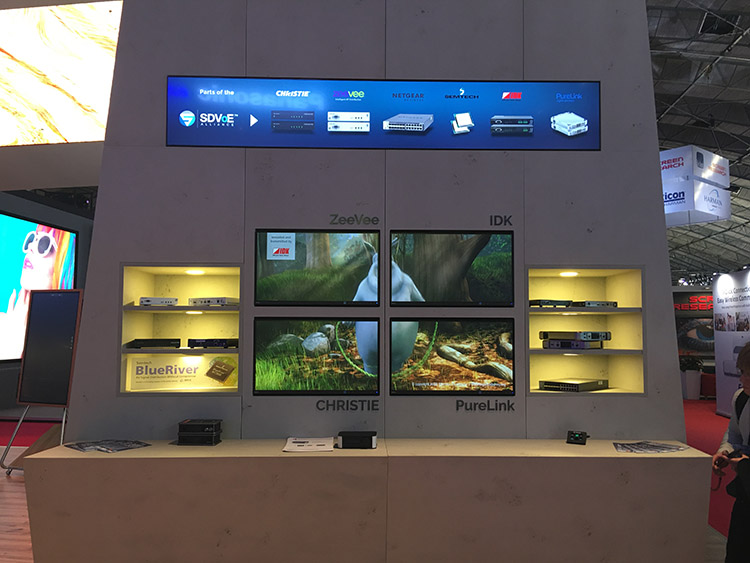Why Interoperability Matters to LANG AG
SDVoE interoperability demo participants on the LANG AG stand at ISE 2019: (left to right) Robert Muddiman (ZeeVee), Charlie Sullivan (ZeeVee), Garth Leach (ZeeVee), Bob Michaels (ZeeVee), Oliver Schnauber (PureLink), Art Weeks (ZeeVee), Stephan Sloot (PureLink), Stephen Metzger (ZeeVee), Robin Cullen (PureLink), Thomas Wendeler (LANG AG), George Vlismas (ZeeVee), Ryohei Iwasaki (IDK), Nick Wheeler (Christie), Jay Rennies (IDK), Vanya Levy (Semtech), Gerry Wilkins (Semtech), Charles Dobson (Semtech), Pierre Sicard (Semtech). Missing: Laurent Masia (NETGEAR)
Now that ISE 2019 is over, there is growing knowledge about the capabilities and success of the SDVoE Alliance in the AV community and even the world. The facts, the features, the benefits – all these were heard and understood by critics in the conventional AV market. “AV over IP” has certainly become a buzz word, and it seems that now is the right time to start switching video on the IP network.
It was quite another situation only one or two years ago! In the beginning of the SDVoE Alliance, different members started to develop the first products. Interoperability was not a primary focus because every company wanted to sell their own product. The benefit of compatibility between manufacturers was not emphasized, leaving behind those designers who would like to have total flexibility to choose which products would best fit their needs.
With this in mind, my colleagues and I proposed a plugfest to the SDVoE Alliance. The event was organized at LANG AG in Lindlar, Germany, in October 2018. The goal was to test compatibility between SDVoE member products, without the manufacturers needing to customize or modify the products. For the initial plugfest, products from Christie Digital, ZeeVee, IDK, and PureLink were tested. (Since the original test, other member products have been tested as well.)
Because the products are all based on Semtech’s BlueRiver chipset, we expected that the encoders and decoders should be able to send AV signals across the network to one another, regardless of manufacturer. The result of the initial plugfest was conclusive: SDVoE products interoperate with one another simply and easily. We were not so surprised this had worked, but at how easy it was to realize a working system, even with only basic control software from Semtech. To ensure this result would reach the AV world, LANG AG featured a demonstration of SDVoE capabilities at our 2019 ISE stand.

In different segments of the Pro AV market it is essential to have the choice of the vendor and the right product to create the perfect setup. In rental & staging, some customers have a short list of preferred product vendors, yet often no single vendor can serve all of the customer’s needs. Being able to mix systems together in a such highly flexible way with SDVoE is a powerful benefit that has been unavailable with proprietary AV-over-IP systems and unavailable with matrix switching systems.
Delivery of uncompressed 4K with SDVoE was shown by 29 member companies as well as the independent LANG AG during ISE 2019. The acceptance of 10 Gbps switch ecosystems is well underway with prices falling to less than $100 per port (much cheaper than HDBaseT matrix ports). On the other hand, the diversity of SDVoE endpoints is increasing very fast. Almost 160 different devices from more than 40 members of the SDVoE Alliance found their way to the market and more were introduced at the show. Tests by alliance members and by LANG AG have proven the interoperability of encoders and decoders on the SDVoE platform. Direct inputs will follow up for displays, projectors and LED systems such as Christie’s MicroTiles LED.
With SDVoE, the transformation of the common matrix is going well. Besides interoperability, SDVoE offers extra features that bring solutions without a need for extra hardware. As an example, the video wall and multiviewer technology is enough to change the mind of someone who was hesitant to leave the matrix switch behind. Signal conversion from electrical to fiber is no longer required, because SDVoE-based systems address both standards at the same time. System integrators can offer less hardware with more features!
Discussions of latency will be left behind because the 0.1 milliseconds introduced by SDVoE doesn’t affect the signal chain, whereas systems that compression down to 1 Gbps introduce enough latency to interfere with performance. In the world of 10 Gbps there are no compression artifacts to bother system users. In fact, the compression can only be detected by expensive test equipment – and only on high-noise content.
There are so many reasons to switch away from the matrix to a new way of AV distribution, and it makes sense to change right now. From a technical point of view, the world is ready to go ahead for AV over IP. The SDVoE Alliance is transforming the matrix with a strong community and a large pool of brand new equipment. SDVoE’s 4K performance is uncompromising. The coming years will certainly be interesting as we see the movement of technology from the matrix switch we have today, to a full IP-based environment. Let’s start switching together!


